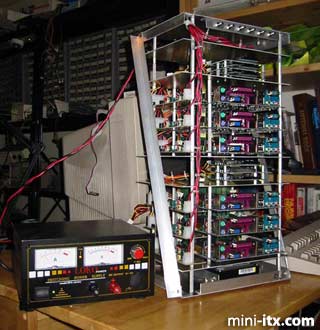Student and professor build budget supercomputer
http://www.calvin.ed...8/microwulf.htm
August 30 , 2007
When Tim Brom 07’ set out to build a budget supercomputer with Calvin computer science professor Joel Adams, he didn’t know the product of his efforts might end up in his checked baggage headed for England.
Brom, now a graduate student at the University of Kentucky continuing his studies in computer science, worked with Adams to build Microwulf, a machine that is among the smallest and least expensive supercomputers on the planet.
“It’s small enough to check on an airplane or fit next to a desk,” said Brom.
This may prove useful next summer when Brom and others from his graduate program travel to England to do work that will require “a significant amount of computing power.” And as the price of commercial supercomputers is often prohibitive for many educational institutions, bringing a “personal” supercomputer like Microwulf could be a cost-effective solution for the group of graduate researchers.
“So far as we can tell, this is the first supercomputer to have this low price/performance ratio—the first to cost less than $100/Gflop,” said Adams.
This is a significant achievement considering that Microwulf is more than twice as fast as Deep Blue, the IBM-created supercomputer that beat world chess champion Gary Kasparov in 1997, and cost only a fraction of the $5 million spent to build Deep Blue.
Microwulf has been measured to process 26.25 gigaflops, or 26.25 billion double-precision floating point instructions, per second. It achieves this performance by relying on four dual-core motherboards connected by an 8-port Gigabyt Ethernet switch. The connected components form a three-tiered system that looks like a triple-decker sandwich.
Supercomputers like Microwulf are used to solve problems that take too much number-crunching for an ordinary desktop to handle, either because its processor is too slow, or because it doesn’t have enough memory, said Adams. Truly huge supercomputers (more than 100 times as fast as Microwulf) are used by organizations like the National Weather Service to process meteorological data and by the United States Missile Defense Agency to simulate nuclear tests.
Microwulf is considered a Beowulf cluster, a group of networked computers that run open source software and work in parallel to solve a single problem. Beowulf clusters are so named because their homemade, cost-effective nature liberates researchers from expensive commercial options for super-computing, much like Beowulf of the Old English poem liberated the Danes from the tyrannical rule of Grendel.
Do Brom and Adams see themselves as “liberators” by unveiling of a system like Microwulf?
“We’re taking the liberation a step further,” said Adams. “Instead of a bunch of researchers having to share a single Beowulf cluster supercomputer, now each researcher can have their own.”
Just two years ago, building a personal supercomputer like Microwulf for the price of a high-performance desktop was out of the realm of possibility for Adams and Brom. But when they saw a portable Beowulf cluster called Little Fe at a conference in October 2005, they began to think about building their system.
“I was really enjoying my high-performance computing class and wanted to keep working in that area after the class ended. I was also thinking about graduate school at the time and a project like Microwulf looks good on a curriculum vitae,” said Brom.
So by the summer of 2006 when the price of hardware materials needed to build Microwulf had gone down, Adams asked his academic department to provide $2500 for the project. He also asked Brom, then beginning his last year at Calvin, to help him build the supercomputer. In January of 2007, they began to piece together their system and by March, they were running tests to see just what Microwulf could do. In the end, the project came in under budget with Microwulf donning a price-tag of just $2470. With current hardware prices, another system like Microwulf would cost half of what it cost Adams and Brom to build earlier this year.
Though supercomputers are typically evaluated on their price/performance ratio, Adams built Microwulf giving attention to its power/performance ratio as well. In other words, he wanted to pay attention to the system’s energy consumption.
“This is becoming increasingly important, as excess power consumption is inefficient and generates waste heat, which can in turn decrease reliability,” said Adams on his Web site.
Adams and Brom managed to build Microwulf so that it could plug into one standard 120V wall outlet. This feature only enhances the system’s portability, allowing it to be taken to classrooms and other research labs where large power supplies are unavailable.
Adams isn’t going to let Microwulf gather dust in the supercomputing lab in the Science Building. Instead he’s going to take it out on the road, mostly to middle school and high school classrooms to try and get teenagers hooked on computer science.
Microwulf’s inventors aren’t set on keeping their blueprints for the supercomputer a secret. In fact, they’ve just published a detailed description and evaluation of their project on Cluster Monkey so others can build their own portable and affordable supercomputers.
It remains to be seen whether Brom will be able to get his wire-filled personal supercomputer past airport security next summer.
~written by Allison Graff, web communications coordinator


















































